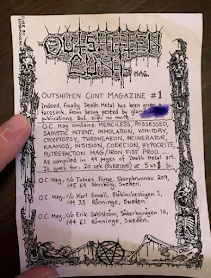I am greatly displeased at the outcome of the work I've created during this module. My personal life has got in the way, along with self-isolating, and illustrating for a children's book became a huge barrier in itself as undertaking this competition brief has taught me that children's book illustration no longer aligns with my interests. It's no longer something I'm genuinely interested in, like I was in Access to HE and Level 4, as I've greatly changed as a person by life's trauma and my mental illness. Children's book are no longer a comfort. I tried to rekindle a fire with this module that has truly burnt out.
If I was to do this module again, which I would love to do, I would choose the Secret 7 competition brief and produce a record sleeve for the Foo Fighters song that is available to illustrate for on there. Vinyl has become a great interest of mine so I have plenty of sleeves to contextualise and draw inspiration from. I would look to the Death Metal scene and the printed ephemera surrounding it, created by musicians themselves, to share with a small, niche audience.
Artist Research: Tobias Forge
"Outshitten Cunt" zine, issue 1
Tobias Forge is Ghost's frontman and "mastermind" - writing all the music, playing the instruments in the studio recordings and deciding stylistically where he wants to direct his project and how he wants everything to look from merchandise to stage shows. I've already made a post about Ghost on my PP blog and the parodying of Catholicism, but I want to look at Tobias' younger days and his connection to the Death Metal scene in Sweden where he is from.
• Like punk, death metal is a counter-culture / subculture, focusing on the rejection of religion (particularly Christianity and Catholicism), choosing to use imagery of the devil / satan, pentagrams, decrying bodies, skeletons, and foul language to provoke. Death Metal scenes are prevalent in Scandinavian countries like Norway, Finland and Sweden where the Church has a lot of power.
In his youth, Forge was a part of a number of Death metal projects including Superior and Repugnant, where he designed the logos and printed ephemera himself.
• Designing band logos: Each band is easily recognisable by a symbol, an emblem, that can easily be applied to a variety of media. It usually involves a shape or type stylised into a shape which can then be turned into a patch for fans' battle jackets where they display their favourite bands proudly. Forge designed the Ghost logo too. He tends to sketch out the idea using an ink pen before adding shapes and symbols to the lettering to define it.
• Designing death metal zines. Aura of the hand-made, analogue, lo-fi. Cut, collaged and photocopied together. Black and white, cheap coloured paper. Quick process to produce a large quantity and reach a large audience within a scene to give contact details and band news.
• Zines contain record and gig reviews, information about the band and the members, news updates and contact information to reach the right people
• Tape trading and cassette design - easy to hand out at shows and build a network of connections. Lo-fi and cost effective
• How is this relevant to me and my practice? I've started to enjoy death metal, metal and the subculture surrounding it these past few years and I'm greatly interested in the ephemera created and shared with an audience. I like the element of the hand made, the crafting process, the conservation of constraints and dimensions, and see these as art pieces in themselves.
• As someone who has been letting go of the idea of perfect outcomes these past few years, the distressed and grungy visuals appeal to me ad give these pieces an element of authenticity and ownership. I'd like to create work like this in my practice.
--
If I were to do Studio Brief 2 again, which I would love as I have created no outcomes during a difficult time, I would like to draw up a proposal focusing on mental health and suicide and the idea I have to creat a series of self care cards to use when you are most at risk.
• Self Care cards (creating 6 for the desired number for this brief) to use when feeling suicidal. Shuffle the deck and pick a card to help comfort you during a traumatic time.
Things that have helped me when I feel severely depressed and I can illustrate on the cards:
- Take a shower / perform a self care ritual
- Change your bedding
- Light a candle
- Listen to your favourite song / album
- Reach out to a friend or family member
- Hug your pet
I would look at what exists already in the market and whether this idea is unique. I would look at different decks of tarot cards to help me to understand applied illustration to a small square or rectangle nd how best to use the composition.
• I would draw from my own experiences


















































